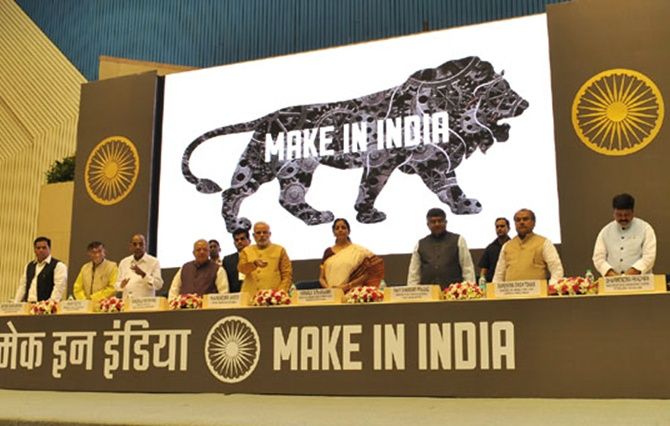 | « Back to article | Print this article |
The aim for the foremost Indian companies should be to create value, notes Subir Roy
 How do India’s current concerns measure up to the concept ‘design thinking’, much in vogue in the world of business?
How do India’s current concerns measure up to the concept ‘design thinking’, much in vogue in the world of business?
The country has just been aggressively launched into a campaign to ‘make in India’ in order to overcome its manufacturing deficit.
This is unexceptionable -- but is India trying to board a train that has already left?
At a time when value added through large-scale (read commoditised) manufacturing is lagging behind, the more desirable aim, the argument goes, should be to get the maximum out of the notion ‘serviced out of India’.
Not only does it tie up with what India is good at, value added through services in the United States, a key market for India, is about three times higher than through manufacturing.
But to get the best value out of services, or for that matter any offering, it is necessary to think things out in a comprehensive way.
And to make that happen, what the most progressive firms are now adopting is ‘design thinking’.
New Infosys chief Vishal Sikka has indicated that this is the route that his firm should follow in order to get out of the ‘downward spiral’ in which the entire Indian software sector is caught.
Design thinking is not designing as traditionally understood -- though this is where designing has been taken most importantly by Apple.
So a brief look is needed at how designing has evolved and Apple’s role in its latest evolution.
Industrial design entered man’s life in society just over a hundred years ago with the arrival of the Ford Model T car that aimed at being functional and durable and didn’t care about looks.
This gave General Motors the chance to design and launch good-looking cars like Chevrolets and eventually beat the Model T in numbers.
It is from the early 1950s that the presence of designing became pervasive with the mass launch of consumer electronics, cars and consumer packaged goods -- all made to look good.
From the 1960s onwards, design turned its focus to functionality and the reigning credo became ‘handsome is as handsome does’, not looks.
A new era in designing dawned with the launch of the Apple Macintosh and the Mac Portable in the 1980s, aimed at designing to enhance consumer feel and experience.
The Apple fan club has not looked back since.
While these were aimed at maximising consumer satisfaction -- understanding what the consumer wants and giving it to her -- the current era in designing can be said to have begun with the launch of the iPod at the turn of the century, which touched the subliminal consciousness of the consumer to find out what she could be wanting soon.
This took designing beyond technology and aesthetics to creating ‘cool’ products that have an emotional connect.
Design thinking similarly embraces a range of functions and is an entire discipline, according to Tim Brown, chief executive of IDEO, a global design and consulting firm.
It is the result of the designer’s sensibilities and methods seeking out people’s needs and trying to meet them with technology and a business strategy that creates customer value and market opportunity for the firm.
Design thinking solves not today’s problems but anticipates those that are ahead, Nitin Pai of Tata Elxsi has said in a discussion in this paper.
It is an outcome, not a process, feels Ripul Kumar of Kern UX.
Design thinking involves the entire firm, not just designers, and has to build an enterprise social network, argues Vinodh Chelambathodi of Intellect Design Arena.
It is a suite of tools, methods and processes; not a product but a mindset within an organisation.
The aim for the foremost Indian companies should be to create value, wherever with whatever, in an age when low trade barriers will allow you to import any component or product from anywhere and offer any service out of anywhere.
The aim of economic planners and governments has to be to create an ecosystem that supports the growth of design-thinking firms.
The Chinese economy is trying to shift jobs out of low-value-added manufacturing to services. In India, a firm like Infosys is seeking to shift its thinking people out to Silicon Valley!
Products that will address the needs that are likely to emerge tomorrow can be anticipated only by firms with the most robust design-thinking systems in place.
But felt needs crying out for solutions are around for everyone to address.
One of them is very low-cost smartphones that run on very little battery power.
Barely literate citizens should be able to use these to access e-governance facilities.
For this, there is also the need to develop a range of simple and easy-to-operate apps. This covers both hardware and software and the product, once developed, has to be marketed to large numbers of the unconnected poor.
The list of such needs can be endless.
The policy approach has to be not to think in terms of manufacturing or service offerings but creating an environment that can help innovative design-thinking companies to grow. Once they flourish, they can do the rest.
Image: Prime Minister Narendra Modi at the inauguration of the ‘Make In India’ in New Delhi. Photograph: Kind courtesy, PIB